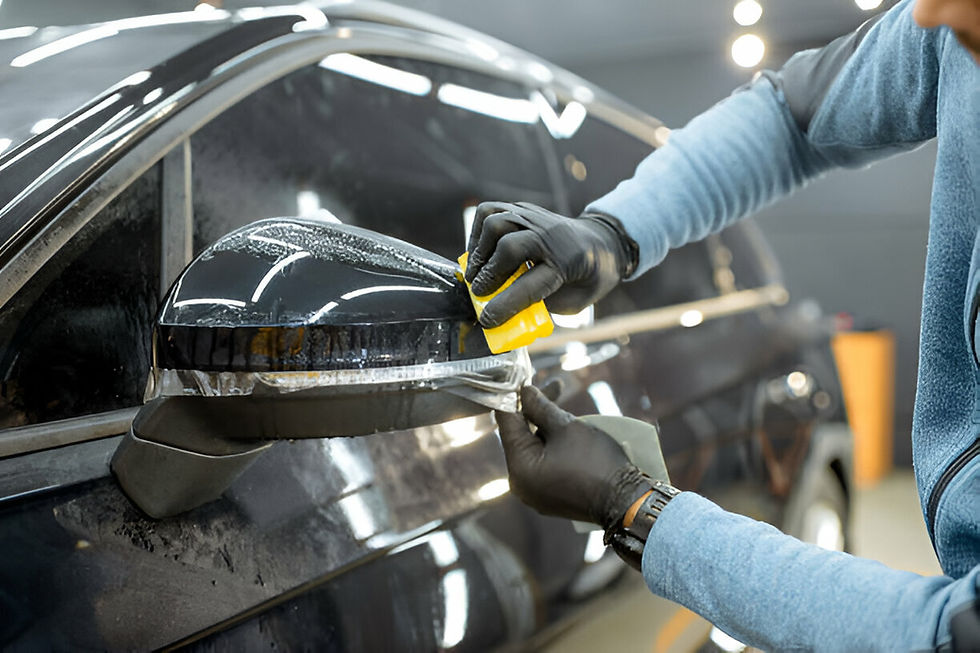Steps for Proper Application of Paint Protection
- kristinannieblog

- Aug 8
- 3 min read
Updated: Aug 25

A fresh coat of paint can drastically transform the visual appeal of any object or environment. However, the journey doesn't end here. Protecting your paint job is a crucial step that proffers longevity and durability. In this comprehensive guide, we will highlight the ins and outs of paint protection, ranging from the benefits, types, right choices, application tools, to procedural instructions. Let's plunge into it.
What is Paint Protection
In simple terms, paint protection can be viewed as a guardian angel for your paint job, it keeps the paint as fresh as new, providing lasting glossy aesthetics. Paint protection products range from films, coatings to sealants and they all serve a singular purpose – to shelter your paint job against potentially harmful elements like UV rays, water, grime, dirt, physical abrasions and more. It's a pivotal aspect of home improvement that helps maintain your investment's visual appeal in the long term.
The Benefits of Investing in Quality Paint Protection
Investing in quality paint protection offers numerous tangible benefits including extended longevity of your paint job, resistance against harsh weather conditions and potential physical damages. Moreover, it optimises colour vibrancy and gloss, together lending an impressive aesthetic appeal that lasts long. The intangible benefit lies in the satisfaction of maintaining a fresh look over extended periods, and subsequent compliments you receive from visitors.
The Different Types of Paint Protection
Paint protection comes in three predominant categories: films, coatings, and sealants. Paint protection films are robust vinyl sheets applied directly to the painted surfaces, providing a substantial protective layer against scratches and chips. Coatings, on the other hand, offer a semi-permanent solution, bonding with the paint surface and serving a protective glossy layer lasting for years. Finally, sealants offer a short-term solution, providing a protective layer that needs to be reapplied usually every few months. Deciding the right type depends on the personal preferences, the condition and type of surface, budget and more.
Determining Which Type of Paint Protection is Right for You
Selecting the right paint protection is influenced by several factors. If you live in an area frequently lashed by harsh climatic conditions, you might want to opt for a more robust solution like a film or coating. Generally, surfaces exposed to the outdoor environment require more substantial protection compared to the indoor counterparts. Your budget plays a vital role too; coatings and films are pricier than sealants but offer long-term protection.
Equipment Required for Applying Paint Protection
The basic set of tools required for paint protection application include, a primer, the paint protection product of your choosing, microfiber cloths, applicator pads or brushes and cleaning material. You might also need a lathing tool in case of applying a film.
Step-by-Step Guide to Applying Paint Protection
It's time to roll up your sleeves and get to work. However, remember that the surface preparation is crucial to achieving a flawless finish.
Surface Preparation: Prior to the paint protection application, ensure the surface is cleaned thoroughly. Any dust, grime or existing scratches and chips might hinder the final result. The paint surface should be spotless and smooth.
Primer Application: A well-applied primer ensures the paint protection adheres well to the surface. Make sure to choose a primer compatible with the type of paint and your chosen paint protection product. Apply the primer evenly and allow it to dry completely.
Paint Protection Application: Now comes the main part. Depending on your chosen product, you would either be brushing a coating/sealant, or applying a film. Make sure to follow the individual product's instruction guide. Apply evenly and ensure all spots are covered.
Post Application: Once the protection is applied, allow it to dry completely. If you used a film, make sure there are no bubbles or creases. Once set, routinely clean the surface with a microfiber cloth to maintain the shine and longevity.
Troubleshooting Common Paint Protection Application Problems
Occasionally, you might encounter some common issues with the paint protection application. Bubbles or creases are common with films, which can be smoothed out using a lath and being patient during the application. Coating or sealants might flake if not applied on a dry, clean surface. Always remember, preparation is key.
Tips to Extend the Life of Your Paint Protection
To maximise your paint protection's lifespan, regular cleaning is advisable. Avoid harsh chemicals or brushes that can potentially damage the protection layer. Conduct routinely check-ups and reapply when necessary.
Final Thoughts
Venturing into DIY paint protection might seem daunting initially, but armed with the right information and method, you can breathe life into your paint job and preserve it for years. Begin your journey towards a sustained glossy finish with this comprehensive guide. Dive in and taste the satisfaction of a job well done.








Comments